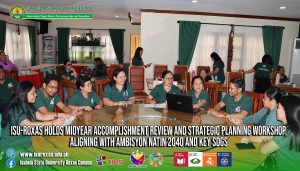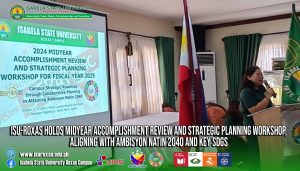
On October 3-4, 2024, the Midyear Accomplishment Review and Strategic Planning Workshop for Fiscal Year 2025 took place at Maria Lourdes Mansion and Resort, Barangay Naganacan, Santa Maria, Isabela. Organized by the Planning, MIS, and GAD Office, headed by Asst. Prof. Joey C. Cereno, the event aimed to review the institution’s progress and strategically plan for the next fiscal year, all while aligning with the national vision, Ambisyon Natin 2040. This effort also integrated key Sustainable Development Goals (SDGs), reinforcing the institution’s commitment to global progress.
The two-day workshop brought together administrators, department heads, and local government officials to collaborate and share responsibility for shaping the institution’s future. Ms. Wendy A. Martin, GAD Alternate Focal Person, and Dr. Rosalyn L. Bautista, Campus Administrator, opened the event with messages of unity and purpose. Dr. Bautista emphasized the ambitious goals of the institution, remarking, “Walang mahirap kapag tayo ay sama-sama” (Nothing is difficult when we work together). Local leaders, including Mayor Jose Phillip F. Calderon of LGU Mallig, Mayor Jonathan Jose C. Calderon of LGU Roxas, and Mayor Jimmy S. Gamazon, Jr. of LGU Quezon, expressed their support for the institution’s strategic goals, reinforcing the value of SDG 17: Partnerships for the Goals.
The first day of the event focused on reviewing the Midyear Accomplishment Report presented by Asst. Prof. Joey C. Cereno, highlighting the institution’s progress across various initiatives, including advancements in SDG 4: Quality Education. Presentation from Mr. Rodel P. Sarmiento, Director for Administration and Finance Services, further provided insights into the status of programs, aligning them with the financial strategies required for sustainable growth.
Workshops played a central role in the event, with participants engaging in the preparation and presentation of Action Plans by Key Results Areas (KRAs). These workshops emphasized the importance of planning for SDG 9: Industry, Innovation, and Infrastructure, ensuring that the institution remains competitive and forward-thinking, particularly in terms of technology and infrastructure development. The collaborative atmosphere allowed for diverse perspectives to shape a comprehensive and strategic roadmap for the future.
On the second day, the focus shifted to resource management and governance, both of which are essential for the institution’s sustainable future. Dr. Domingo M. Ramos, Director for Resource Generation, discussed strategies for generating resources, directly supporting SDG 9, while Mr. Rodel P. Sarmiento addressed governance plans aimed at enhancing efficiency and transparency. Additionally, AR. Acee S. Manganan, the Campus Architect, presented the Land Use Development and Infrastructure Plan (LUDIP) for the Rang-ayan site, which integrates SDG 13: Climate Action through sustainable infrastructure planning, ensuring the institution’s growth does not compromise environmental stewardship.
 The event also covered updates on ICT and office equipment acquisitions, presented by Mr. Alfredo G. Sarte, ensuring that the institution remains at the forefront of technological advancements to support both educational and operational excellence.
The event also covered updates on ICT and office equipment acquisitions, presented by Mr. Alfredo G. Sarte, ensuring that the institution remains at the forefront of technological advancements to support both educational and operational excellence.
The workshop concluded with a benchmarking session and the awarding of certificates, with Dr. Leinelie D. Balagan delivering the closing remarks. Dr. Balagan reiterated the collective effort required to achieve the institution’s long-term goals in alignment with Ambisyon Natin 2040 and the SDGs, particularly highlighting the role of education, infrastructure, climate responsibility, and partnerships.
This workshop not only reviewed the institution’s accomplishments but also solidified its commitment to long-term growth, sustainability, and development, with a clear focus on Quality Education (SDG 4), Industry and Infrastructure (SDG 9), Climate Action (SDG 13), and Partnerships for the Goals (SDG 17). Through collaborative planning, the institution is poised to make meaningful contributions to both the local community and the global sustainable development agenda.








